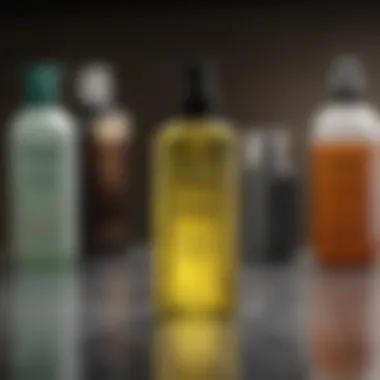Unveiling the Hazardous Chemicals to Steer Clear of in Everyday Products


Well-Being Overview
In today's fast-paced world, where everyday products are an integral part of our lives, it is crucial to be aware of the harmful chemicals that can potentially affect our health. This article aims to shed light on the hazardous substances commonly found in items we use daily, emphasizing the importance of making informed decisions for our well-being. By understanding and avoiding these chemicals, individuals can take proactive steps to safeguard their health and minimize exposure to harmful compounds.
Introduction to Harmful Chemicals
The modern consumer market is flooded with products containing a multitude of substances, some of which may have detrimental effects on our health. It is paramount to recognize and scrutinize the ingredients listed on product labels to identify potentially harmful chemicals. By cultivating a habit of reading labels and being conscious of what we expose ourselves to, we can take control of our health and well-being.
Common Harmful Chemicals
Certain chemicals commonly found in everyday products have been linked to various health concerns, including skin irritation, respiratory issues, and even potentially serious conditions such as cancer. Some notable chemicals to steer clear of include parabens, phthalates, triclosan, and formaldehyde. Understanding the adverse effects of these substances equips consumers with the knowledge needed to make informed choices and protect themselves from unnecessary harm.
Adverse Health Effects
Exposure to harmful chemicals in products can lead to a range of health issues, both immediate and long-term. Skin reactions, respiratory problems, hormonal disruptions, and even the development of chronic diseases are among the potential consequences of prolonged exposure to toxic substances. By being vigilant about the products we use and the ingredients they contain, we can significantly reduce the health risks associated with these harmful chemicals.
Strategies for Minimizing Exposure
To diminish the risks posed by harmful chemicals in products, individuals can adopt certain practices to minimize their exposure. Opting for natural and organic products, reading labels diligently, and choosing products free from identified toxic ingredients are effective strategies for reducing chemical intake. Additionally, being aware of the potential health effects of common chemicals allows consumers to make informed decisions and prioritize their well-being.
Conclusion
Navigating the landscape of consumer products can be daunting, given the prevalence of harmful chemicals in everyday items. However, by arming oneself with knowledge about these substances and their potential effects, it is possible to make conscious choices that promote health and wellness. By prioritizing caution and awareness in product selection, individuals can safeguard themselves from the adverse impacts of toxic chemicals and strive for a healthier, more sustainable lifestyle.
Introduction
In this intricate weave of understanding and awareness lies the heart of our discourse - the exploration of chemicals that intertwine with the products we encounter every day. As we peel back the layers of labels and ingredients, a profound realization dawns - the potential impacts on human health are vast and significant. This introduction serves as a gateway to a realm where knowledge becomes power, empowering individuals to navigate the murky waters of harmful substances and safeguard their well-being amidst a sea of consumer goods aiming to captivate.


Overview of Harmful Chemicals
Amidst the vast array of everyday products resides a hidden truth - the presence of insidious chemicals that quietly permeate our lives. From parabens to phthalates, sodium lauryl sulfate (SLS) to formaldehyde, and triclosan, these compounds weave a complex tapestry of health risks when left unchecked. Unraveling the threads of each chemical reveals a disturbing narrative of potential harm lurking beneath the surface of the daily essentials we often take for granted.
Purpose of Identifying Chemicals to Avoid
Why do we embark on the unending quest to uncover and avoid these chemical assailants? The purpose is clear - to safeguard our well-being, to shield our bodies from the repercussions of exposure, and to reclaim a sense of control over what we allow into our personal ecosystems. By arming ourselves with knowledge and discernment, we pave the way for informed decisions that resonate with a desire for health and longevity. The pursuit of identifying hazardous chemicals is not merely a task; it is a declaration of self-care and a testament to the value we place on our own wellness.
Common Harmful Chemicals
In the realm of consumer products, understanding and recognizing common harmful chemicals are paramount. These substances, often lurking in everyday items, can have adverse effects on human health, necessitating a discerning eye when selecting goods for personal use. By shedding light on these pervasive toxins, consumers can take proactive steps to safeguard their well-being and reduce potential risks associated with exposure to harmful compounds.
Parabens
Parabens, frequently used as preservatives in cosmetics and personal care products, have garnered attention for their potential health risks. Studies have linked parabens to hormonal disruption, raising concerns about their impact on reproductive health and endocrine function. Despite their effectiveness in prolonging product shelf life, the presence of parabens underscores a need for greater scrutiny in labeling practices and ingredient selection. Awareness of parabens empowers consumers to make informed choices, favoring products free from these concerning additives.
Phthalates
Phthalates, commonly found in fragrances, plastics, and skincare items, pose a worrisome threat due to their potential negative effects on hormonal balance and reproductive health. These pervasive chemicals have been associated with developmental issues in children and hormone-related complications in adults. By steering clear of products containing phthalates and opting for phthalate-free alternatives, consumers can mitigate exposure to these hazardous compounds, prioritizing their health and well-being.
Sodium Lauryl Sulfate (SLS) and Sodium Laureth Sulfate (SLES)
Sodium Lauryl Sulfate and Sodium Laureth Sulfate, prevalent in many personal care products for their foaming and cleansing properties, can trigger skin irritation and sensitization in susceptible individuals. Despite their widespread use, these sulfates offer little substantive benefit beyond aesthetic appeal, prompting informed consumers to scrutinize labels diligently. With a growing emphasis on skin-friendly formulations, individuals are increasingly opting for SLS and SLES-free alternatives to prevent potential skin reactions and maintain dermatological health.
Formaldehyde
Formaldehyde, a known carcinogen, is often present in beauty and household products as a preservative. The use of formaldehyde-releasing agents in consumer goods poses significant health risks, with potential links to cancer and respiratory ailments. Given the severe implications of formaldehyde exposure, consumers are advised to be vigilant when selecting products, favoring formaldehyde-free options to reduce health hazards and promote well-being.


Triclosan
Triclosan, a common antibacterial agent in soaps and personal care items, has raised concerns due to its potential contribution to antibiotic resistance and environmental harm. The pervasive presence of triclosan in consumer goods underscores the need for heightened awareness regarding its adverse effects on both human health and ecosystems. By opting for triclosan-free alternatives and embracing environmentally-conscious practices, consumers can play a pivotal role in reducing exposure to this concerning chemical and fostering sustainable habits for a healthier future.
Health Risks Associated with These Chemicals
The section on health risks associated with these chemicals delves into the crucial aspect of how certain chemicals commonly found in everyday products can negatively impact human health. It is imperative to highlight these risks to educate consumers on the potential dangers they may face by using products containing harmful substances. By understanding the health risks associated with these chemicals, individuals can make informed decisions to safeguard their well-being and minimize exposure to toxic compounds present in various consumer goods. This in-depth exploration provides valuable insights into the necessity of identifying and avoiding harmful chemicals to protect oneself from potential health repercussions.
Hormonal Disruption
Hormonal disruption is a significant concern when it comes to exposure to certain chemicals present in everyday products. The interference with the body's endocrine system can lead to a variety of health issues, ranging from reproductive disorders to metabolic disruptions. Understanding how these chemicals disrupt hormonal balance is crucial in mitigating their effects on overall health and well-being. By identifying products containing substances known to cause hormonal disruption, individuals can take proactive steps to limit their exposure and protect themselves from potential hormonal imbalances and associated health complications.
Carcinogenic Properties
The discussion on carcinogenic properties sheds light on the link between certain chemicals found in everyday products and their potential to induce cancer. Exposure to carcinogens can significantly increase the risk of developing various types of cancer, making it essential for consumers to be aware of these substances and their presence in the products they use. By examining the carcinogenic properties of common chemicals, individuals can make informed choices to reduce their exposure to potential carcinogens and lower their risk of developing cancer-related diseases.
Skin Irritation and Sensitization
Skin irritation and sensitization are common concerns associated with the use of products containing certain harmful chemicals. These substances can trigger allergic reactions, irritate the skin, and lead to various dermatological issues. Understanding how these chemicals affect the skin is crucial for maintaining healthy skin and avoiding adverse skin reactions. By identifying and avoiding products that contain skin-irritating substances, individuals can protect their skin from sensitization and inflammation, promoting overall skin health and well-being.
Label Reading and Product Selection Tips
Understanding which chemicals to avoid in everyday products is paramount for safeguarding personal health. Seemingly innocuous items like skincare products or household cleaners can contain harmful substances that may have long-term negative impacts. Reading product labels meticulously is a crucial step towards making informed choices. Consumers should pay attention to words such as 'parabens,' 'phthalates,' 'SLS,' 'SLES,' 'formaldehyde,' and 'triclosan,' which are frequently red flags. These substances are known for causing hormonal disruptions, skin irritations, and even carcinogenic effects. Opting for items that are free from these chemicals is advisable for mitigating health risks.
Understanding Ingredient Labels
Deciphering ingredient labels can be perplexing due to the complex scientific names present. However, taking the time to educate oneself on these terms can be incredibly empowering. Ingredients like 'methylparaben' or 'diethyl phthalate' may not immediately ring alarm bells, but being aware of their implications is vital. Look out for terms like 'organic,' 'natural,' and 'fragrance-free,' as they indicate safer alternatives. By understanding and recognizing these components, consumers can actively avoid harmful chemicals and select products that align with their health priorities.


Opting for Natural and Organic Alternatives
The shift towards natural and organic alternatives has gained significant momentum in recent years, and for good reason. Choosing products made from organic ingredients reduces exposure to synthetic chemicals, thereby lowering potential health risks. Natural alternatives often steer clear of harmful substances like pesticides, artificial fragrances, and preservatives, promoting a more holistic approach to personal well-being. By opting for these alternatives, consumers not only prioritize their health but also support sustainable and eco-friendly practices within the industry.
Seeking Certifications and Third-Party Verification
In a market saturated with misleading claims and greenwashing tactics, seeking certifications and third-party verification is crucial. Certifications like 'USDA Organic' or 'Cruelty-Free' provide assurance that products adhere to stringent standards and do not contain harmful chemicals. Third-party verification ensures transparency and accountability, offering consumers peace of mind regarding the products they purchase. By prioritizing certified items, individuals can navigate the realm of personal care and household products with confidence, knowing that their choices align with safety and well-being.
Regulations and Advocacy for Safer Products
Regulations and advocacy for safer products play a pivotal role in ensuring consumer safety and health. In the realm of consumer products, regulations serve as a fundamental framework to monitor and control the use of potentially harmful substances. These regulations set forth standards that companies must adhere to, dictating the permissible levels of certain chemicals or banning them altogether. By imposing these regulations, governing bodies aim to safeguard public health and prevent the sale of products that pose risks to consumers.
Moreover, advocacy for safer products amplifies the impact of regulatory measures. Consumer advocacy groups and individuals champion the cause of safer products by raising awareness, lobbying for more stringent regulations, and holding industries accountable for the safety of their products. This active involvement from advocacy groups serves as a safeguard to supplement existing regulations and drive continuous improvement in product safety standards.
By combining regulatory frameworks with vigorous advocacy efforts, the landscape for safer products becomes more robust and effective. The synergy between regulations and advocacy creates a environment where manufacturers are incentivized to prioritize safety and consumers are empowered to make informed choices about the products they use.
Current Regulatory Landscape
The current regulatory landscape surrounding consumer products reflects a complex interplay between governmental agencies, industry standards, and international bodies. In the United States, the Food and Drug Administration (FDA), Environmental Protection Agency (EPA), and Consumer Product Safety Commission (CPSC) are key regulatory agencies tasked with overseeing different aspects of product safety. These agencies set regulations on allowable chemical concentrations, labeling requirements, and product testing protocols to ensure compliance with safety standards.
Internationally, organizations such as the European Chemicals Agency (ECHA) and the World Health Organization (WHO) contribute to the global regulatory landscape by providing guidelines and recommendations for the safe use of chemicals in products. Recognizing the interconnected nature of global trade, these international bodies play a crucial role in harmonizing regulations across borders and elevating standards for consumer products worldwide. The dynamic nature of the regulatory landscape necessitates constant monitoring and adaptation to emerging scientific findings and technological advancements to effectively protect consumer health.
Role of Consumer Advocacy in Shifting Industry Practices
Consumer advocacy serves as a catalyst for change in the industry by exerting pressure on companies to prioritize safety and transparency. In the face of growing consumer awareness and demand for safer products, advocacy groups act as watchdogs, scrutinizing industry practices and pushing for greater accountability. Through campaigns, petitions, product boycotts, and collaborations with regulatory agencies, consumer advocates drive positive shifts in industry norms and behaviors.
One of the key roles of consumer advocacy is to amplify the voices of the public and hold corporations accountable for their actions. By engaging in dialogue with companies, raising concerns about product safety, and advocating for greater transparency in ingredient disclosure, consumer advocacy groups create a culture of accountability that compels companies to uphold higher standards of integrity and safety. Ultimately, the relentless efforts of consumer advocates contribute to fostering a marketplace where consumer safety is paramount and where companies are held to the highest ethical standards in product development and marketing.
Conclusion
In concluding our exploration into the hazardous chemicals often present in everyday products, it is crucial to emphasize the criticality of vigilance in product selection to safeguard our health and well-being. The significance of this article lies in unraveling the veiled threats posed by these insidious chemicals and empowering consumers to navigate the complex landscape of product ingredients with confidence and discernment. By shedding light on the detrimental effects of substances like Parabens, Phthalates, SLS, SLES, Formaldehyde, and Triclosan, we equip individuals with the knowledge necessary to make informed choices and prioritize their health. This heightened awareness underscores the proactive stance we must adopt in a market saturated with potentially harmful formulations, urging us to be mindful and deliberate in our consumption decisions.
Empowering Consumers Through Knowledge
The cornerstone of consumer empowerment rests on the foundation of knowledge, particularly when it comes to deciphering the cryptic language of ingredient labels adorning products. By delving into the intricacies of chemical compositions and understanding the potential health risks associated with common additives, consumers can reclaim control over their purchasing decisions. This section serves as a beacon of enlightenment in a realm inundated with misleading marketing tactics and greenwashed labels, encouraging individuals to seek transparency and integrity in the products they integrate into their daily routines. Armed with information on certification standards, third-party verification processes, and the benefits of opting for natural alternatives, consumers are equipped to align their purchases with their values and well-being, catalyzing a shift towards a safer and healthier consumer landscape.



